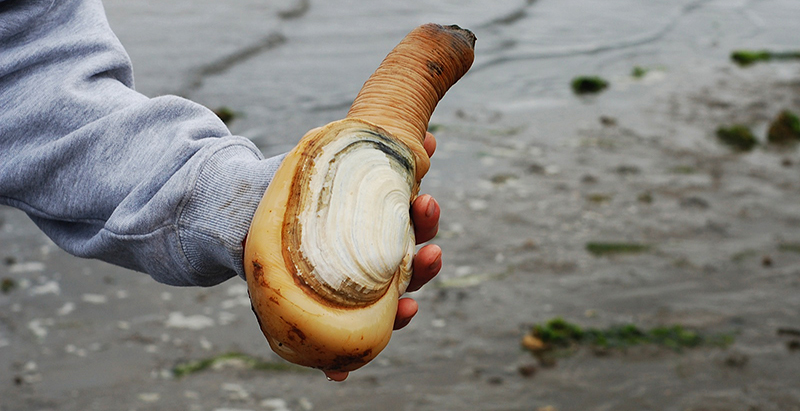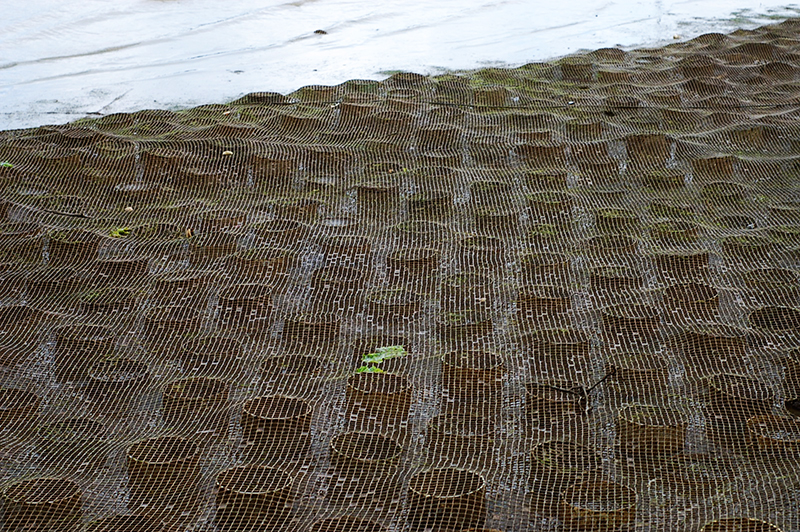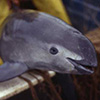
It takes a confident farmer to laugh at his own crop. Fortunately, Steve Marsh, a burly, bearded manager for Taylor Shellfish Farms, has a sense of humor. Marsh grows geoducks (pronounced gooey-ducks), one of the world’s largest, strangest, and most obscene-looking bivalves. “These things definitely take some getting used to,” he warned me on a glorious May morning as we squelched through the viscous mudflats of Washington’s South Puget Sound. We knelt over a tub of freshly harvested geoducks, whose fleshy, forearm-length siphons bore an inescapable resemblance to a human phallus. “I’ve heard every joke under the sun,” Marsh said.
Yet the booming global trade in Panopea generosa is no laughing matter. The giant clams, which dwell in shallow coastal waters from Mexico to Alaska, retail for up to $300 apiece in Asia, where they’ve become a luxury item, particularly for China’s expanding middle class. The strong market has led to a rush on wild geoduck populations. Washington’s fishermen pry around 5 million pounds from the state’s waters annually, and that’s just the recorded haul. According to Mike Cenci, deputy chief of the Washington Department of Fish and Wildlife’s law enforcement program, many undersea beds have been stripped by illegal divers.
Geoducks can live for more than 160 years; some biologists compare poaching the ancient mollusks to lopping down old-growth trees. “We’re getting killed by a thousand cuts,” Cenci says.
The clam’s value, and the state’s desire to reduce pressure on wild stocks, has helped birth a growing industry: geoduck aquaculture. Today, around 1.5 million pounds of farmed geoducks are raised annually in Puget Sound on tidelands that companies lease from private landowners. Growers include everyone from massive companies like Taylor Shellfish, which harvests 700,000 pounds annually, to Native American tribes like the Jamestown S’Klallam.
Environmentalists usually hail shellfish aquaculture as a benign form of food production. Shellfish, geoducks included, are filter-feeders that require no introduced food, no fresh water, and typically no fertilizers or pesticides.
‘Everything is supersized. You’ve got big clams, big business, and big controversy,’ says one scientist.
In contrast to corn or soy, grown in sprawling monocultures, they can be cultivated within mostly intact ecosystems. The Monterey Bay Aquarium’s Seafood Watch labels geoduck “Best Choice,” its highest sustainability rating.
Yet the aquaculture explosion concerns a small but vocal faction of coastal homeowners and conservationists, who argue that the metastasizing industry could do grave harm to the Puget Sound’s ecosystem and aesthetics. Foes fear that geoduck farming could disrupt mudflat animal communities, introduce plastic pollution to the sound’s waters, and catalyze ecosystem-wide chain reactions that affect everything from seabirds to salmon.
“I’ve never been involved in anything so controversial,” says Sean McDonald, an ecologist at the University of Washington’s School of Aquatic and Fishery Sciences, who studies the farms’ environmental effects. “Everything is supersized: You’ve got big clams, big business, and big controversy.”
To comprehend local anxiety, it’s necessary to understand how you grow a geoduck. The process begins when the geoducks are but a few months old, as farmers press the thumbnail-sized, nursery-raised “seed” into the mud of Puget Sound’s intertidal zone. To protect the vulnerable seeds from crabs, birds, and other predators, farmers sheath them in white plastic PVC pipes — typically around 40,000 tubes per acre — and drape netting over the thicket of pipes. As the geoducks grow, they bury themselves deep enough to avoid predation, with only the tip of their long, plankton-slurping siphon protruding from the sand. (The name “geoduck” comes from the Nisqually Indian word gweduc, meaning “dig deep.”) Geoducks take around six years to reach market size. This is not an industry for the impatient.
Once they’ve matured, it’s time to gather the crop. On the day that I visited one of Taylor Shellfish’s sites, a leased property called Foss Farm, the harvest was in full swing. Four workers, young men in waders and tank tops, slogged through the mud during low tide, carrying long hoses hooked up to a water pump aboard an offshore barge. Each hose flooded the sand with low-pressure seawater, turning the firm flats into mush. The workers plunged their arms elbow-deep into the sludge, grabbing the now-dislodged clams as though digging large potatoes. They then hauled their crop to the waiting barge — the first step in a 6,500-mile journey likely destined to end in a hotpot or sushi platter in China, Hong Kong, Korea, or Vietnam.

In the last decade, several coastal homeowner groups have sprung up to oppose this elaborate process. As Laura Hendricks, a shorefront homeowner and representative of the grassroots Coalition to Protect Puget Sound Habitat, sees it, the environmental impacts of geoduck farming are myriad and dramatic. Storms have dislodged pipes and netting, strewing beaches with plastic. Homeowners in farm-saturated Totten Inlet have reported muddy waters and the disappearance of fish. Some farms encroach on eelgrass, underwater vegetation that shelters a menagerie of marine species. The fact that the industry exists primarily to sell luxury items to Asia does not endear it to its opponents. “We’re spending billions to restore salmon, eelgrass, and forage fish in Puget Sound on one hand,” Hendricks says. “But there’s a loss of life every time you put one of these [geoduck farms] in.”
Although the campaign has so far been waged primarily by homeowners, conservation groups are keeping close tabs. Trina Bayard, director of bird conservation for Audubon Washington, is careful to point out that her organization hasn’t yet taken a firm position on the issue. Still, she urges caution. “This is commercial-scale industry occurring in the near-shore zone, which we know is so important for marine birds and ecosystems,” she says.
According to the state’s Department of Ecology, Puget Sound has lost 70 percent of its critical habitat in the last 125 years, and 30 percent of its shoreline is armored by bulkheads, seawalls, and other disruptive structures. Geoduck farming may be a minor form of development compared to those vast changes, but it’s yet another stressor on an ecosystem already being pressured by the weight of human infrastructure. “The idea that birds are potentially being displaced from prime foraging areas is what’s of most concern to me,” Bayard says.
One scientist’s research thus far suggests that geoduck farming is surprisingly benign.
Most vexing of all is the plethora of unknowns. Do filter-feeding geoducks outcompete young salmon and baitfish for plankton? How do the PVC arrays change habitat? How does repeatedly liquefying beaches to harvest geoducks affect the creatures that dwell in the substrate? In 2007, the Washington Legislature sought to fill some of those knowledge gaps by funding a series of studies, led by McDonald and other University of Washington researchers, investigating the environmental impacts of geoduck aquaculture.
McDonald’s research thus far suggests that geoduck farming is surprisingly benign. From 2008 to 2012, his University of Washington team sampled coastal ecosystems before, during, and after harvest to test whether liquefying mudflats was indeed harming intertidal communities. When McDonald examined populations of worms, crustaceans, bivalves, and other mudflat residents, he found that most of the species had returned to normal abundance within four months of harvest and that the few that didn’t immediately recover suffered only minor reductions.
“Coastlines are naturally dynamic places, and these are disturbance-adapted ecosystems,” says McDonald, known in some quarters as the Geoduck Guru. “Compared to a big winter storm, a geoduck harvest may not be that big a deal.” Other phases of geoduck aquaculture appear to create ecological winners and losers: While plastic pipes and netting favor animals that prefer complex habitat, including crabs, other animals, such as flatfish, don’t fare as well. But scientists have found that total species diversity is unchanged.

“The studies to date have shown that the impacts are short-term in nature and small in scale,” says Laura Hoberecht, an aquaculture coordinator with the National Oceanic and Atmospheric Administration, one of the agencies responsible for aquaculture permitting. Hoberecht adds that farming’s impacts pale in comparison to those from other Puget Sound activities, like dredging.
While the University of Washington studies have primarily focused on the spineless denizens of the intertidal, the researchers have also begun to explore more charismatic fauna. “The guy on the street doesn’t care what happens to the amphipods,” McDonald says. “They want to know about killer whales or bald eagles or salmon.”
In September 2015, McDonald’s team published another paper, this one modeling how the future spread of geoduck farms would affect central Puget Sound (most of the current farms are located in the southern portion of the sound). Like its predecessors, the study found that an aquacultural expansion would do little harm to most species, and that more than doubling geoduck density wouldn’t affect plankton stocks. Some fish, like perch, might even benefit by hiding among the pipes.
The industry’s critics acknowledge that some geoduck growers have taken steps to mitigate impacts.
But modeling also suggested that a 120 percent increase in geoduck farms — a realistic scenario — could reduce populations of herons, eagles and other birds, by making it harder for them to forage amid the dense infrastructure — a troubling echo of Bayard’s concerns. Flatfish and salmon also faced potential declines. According to Bridget Ferriss, the study’s lead author, the modeling should help researchers focus their empirical data-gathering efforts on groups of organisms, such as seabirds, that burgeoning aquaculture might affect most.
Their concerns notwithstanding, the industry’s critics acknowledge that some geoduck growers have taken steps to mitigate potential impacts. At the Foss Farm, unsightly PVC pipes have been replaced with mesh tubes that are less conspicuous, allow water to flow through with minimal disruption to tidal cycles, and provide corridors for creatures like moon snails to move through farms. Taylor Shellfish has also changed from noisy gasoline pumps to quieter diesel, and refined its geoduck nurseries to reduce damage to intertidal areas. “We’re always trying to build a better mousetrap,” says Bill Dewey, Taylor’s director of public affairs.
But Laura Hendricks and her supporters aren’t mollified. Opponents are particularly concerned about the cumulative impacts of geoduck farming — the possibility that the collective harm of millions of planted shellfish may be greater than the sum of their parts. “All the research has been at a very short temporal and spatial scale,” says James Brennan, a former biologist with the Washington Department of Fish and Wildlife. “But there’s the strong potential for additive, synergistic effects of repeated harvests.”
For her part, Hendricks proposes moving all geoduck farming from the intertidal zone to the seafloor, where habitat is less sensitive, and where the fields of PVC pipes would be invisible to beachgoers. Although some farms, including Foss, already rely on divers to dig up some of their geoducks underwater, Dewey says underwater harvest may be prohibitively expensive.
ALSO FROM YALE e360In Mexico, Fish Poachers Push Endangered Porpoises to Brink

While homeowners groups have appealed about a dozen new farm permits, their arguments haven’t gained traction with regulators. Two hundred acres of tidelands are currently in production, and only one appeal — of a farm that threatened to encroach on eelgrass beds — resulted in a permit being modified. “We are doing due diligence, and the environmental impacts continue to be minimal or nonexistent,” says Perry Lund, southwest regional supervisor with the state’s Department of Ecology. Lund is skeptical that widespread geoduck farming could inflict cumulative impacts on the Puget Sound. “Zero impacts plus zero impacts still equals zero,” he says.
That maxim will be tested in the years to come: Proposed new farm sites include Burley Lagoon, an inlet that is prime habitat for juvenile salmon and cutthroat trout, and Dungeness Bay, home to a wildlife refuge. As production ramps up, analyzing ecosystem-wide effects will become more important than ever; McDonald, for instance, hopes to launch a new, bird-specific study to test his model’s findings in the field.
“To the regulators, the case is closed — we did our studies, got some results, and they can use that data in permitting,” McDonald says. “But it would be prudent to keep investigating the impacts on other organisms within the food web.”
Correction, June 13, 2016: A photo caption in an earlier version of this article incorrectly identified a clam in Bodega Bay as a geoduck. It was a gaper or horse clam (Tresus capax).